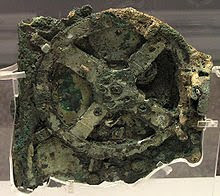This orrery was made in London in 1767 by Benjamin Martin and was used to teach astronomy at Harvard University. It is on display at the Putnam Gallery in the Harvard Science Center.
Image courtesy of Wikimedia Commons
An Orrery is a mechanical model of the solar system. Notwithstanding problems of scale it can be a useful tool in teaching children the relative positions of the planets. Orreries are also very beautiful. Brian Greig, in Victoria, Australia, recreates historical orreries and other scientific instruments and accepts commissions to make bespoke models. His site can be seen here.Until the 16th century the unquestioned commonly and religiously held belief was that the earth was the centre of the universe and the sun, planets and stars revolved around it. Heaven was a fixed place and perfect. Any other opinion was considered to be heresy.
The Polish astronomer and mathematician Nicolaus Copernicus (1473 – 1543) posed the theory that the earth and other planets in the solar system orbited the sun.
Copernicus' view was promulgated by the German mathematician and astronomer Johannes Kepler (1571 – 1630)
Galileo Galilei (1564 -1642) the Italian philosopher, mathematician and astronomer, also supported the Copernican theory, but was accused of heresy by the Roman Catholic church and forbidden to advocate it. He remained under house arrest for the last ten years of his life for refusing to revoke his belief in the theory.
The University of St Andrews has an Electric Orrery showing the inner and outer solar systems.Thank you to Denise Nesbitt and her merry band for their work in organising and hosting this meme. To see more Os – and perhaps join in – please click here.
The Polish astronomer and mathematician Nicolaus Copernicus (1473 – 1543) posed the theory that the earth and other planets in the solar system orbited the sun.
Copernicus' view was promulgated by the German mathematician and astronomer Johannes Kepler (1571 – 1630)
Galileo Galilei (1564 -1642) the Italian philosopher, mathematician and astronomer, also supported the Copernican theory, but was accused of heresy by the Roman Catholic church and forbidden to advocate it. He remained under house arrest for the last ten years of his life for refusing to revoke his belief in the theory.
Orrery in the Vatican Museums
Image courtesy of Wikimedia Commons
The first model of the solar system was made about 1704 by George Graham (1674 – 1751) who was a renowned clockmaker. His tomb is in Westminster Abbey. An instrument maker called John Rowley made a copy of the model for his patron, Charles Boyle, 4th Earl of Orrery. Henceforth any such model would be known as an Orrery.However, in the first century BC Cicero claimed that the Greek philosopher Posidonius, had built an orrery showing the daily movement of the sun, moon and five known planets. It may have resembled the Antikythera mechanism.Main fragment of Antikythera Mechanism - probably the first known orrery
Image courtesy of Wikimedia Commons
There is a Human Orrery at the Armagh Observatory in Northern Ireland.The University of St Andrews has an Electric Orrery showing the inner and outer solar systems.Thank you to Denise Nesbitt and her merry band for their work in organising and hosting this meme. To see more Os – and perhaps join in – please click here.



What a fascinating post for the day, Janice! I really enjoyed it! I always love learning something I didn't know about or knew very little which was the case today! Thanks! Hope your week is going well!
ReplyDeleteSylvia
Great information again thanks for sharing!
ReplyDeleteABC Wednesday~O
Thank goodness our knowledge expands. This is a fascinating look at the orrery and history. Thank you!
ReplyDeleteHow fascinating! I'd never heard of this before.
ReplyDeleteBy far, this is the coolest thing I've learned about in the past month or so! Thanks for the link! What a great site.
ReplyDeleteGreat post. A subject that interests me a lot.
ReplyDeleteI agree, they are very beautiful. Thank you for the history, very interesting.
ReplyDeleteWhat a very interesting post, - this word was new to me, although the history behind it is familiar. Would especially like to take part in the Human Orrery. Thank you for sharing and stirring my brain cells!
ReplyDeleteThey are beautiful objects, never knew they were named after the Earl of Orrery, or even that there was one.
ReplyDeleteI was once part of a human orrery (a team building away-day in case you wonder why). If only I had thought it through before volunteering and somehow got picked to be the moon whizzing round earth. I was certainly envious of those outer planets as I dizzily regained my seat.
Another extremely interesting post and great photographs. My mind has expanded a little tonight thanks to you :)
ReplyDeleteVery spacey, quite literally.
ReplyDeleteROGER, ABC Wednesday team
I can't believe I never heard of this! What an informative, interesting post! I will have to look out for these. I have been to the oratory in Toronto - a long time ago though. Fascinating place!
ReplyDeleteWhile I have heard of and seen orreries I was not familiar with the history. Fascinating information, thank you for sharing. I'm on my way now to check out the Human Orrery.
ReplyDeleteNever knew their name, thanks for an interesting and educative post!!
ReplyDeleteO is for...
How very interesting! Thank you for sharing this information! I learned something new!
ReplyDeleteGreat post for the O day, and very interesting info!
ReplyDeleteA most interesting post! I knew about Galileo, poor man, but much of the rest was new to me!
ReplyDeleteA fascinating post and a great choice for ABC Wednesday's 'O'.
ReplyDeleteThanks for visiting The Fairweather Blogger - the Operation was a success, though I wish that the morphine hadn't worn off so quickly!
Gary